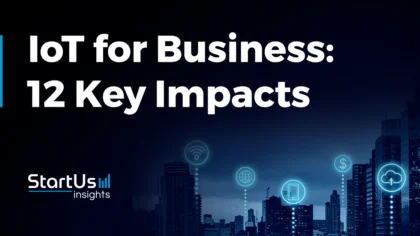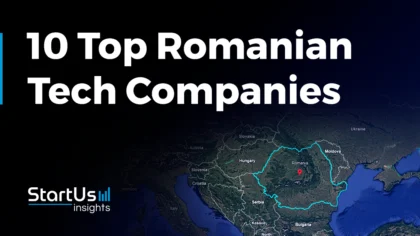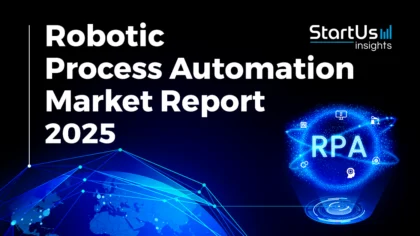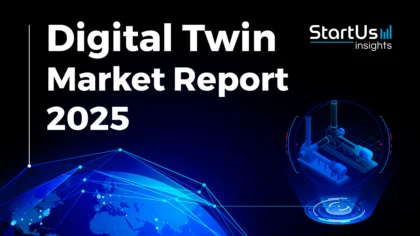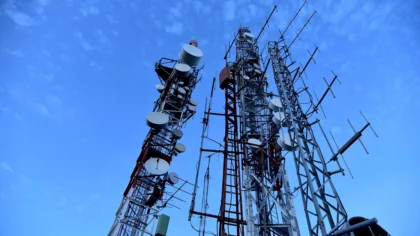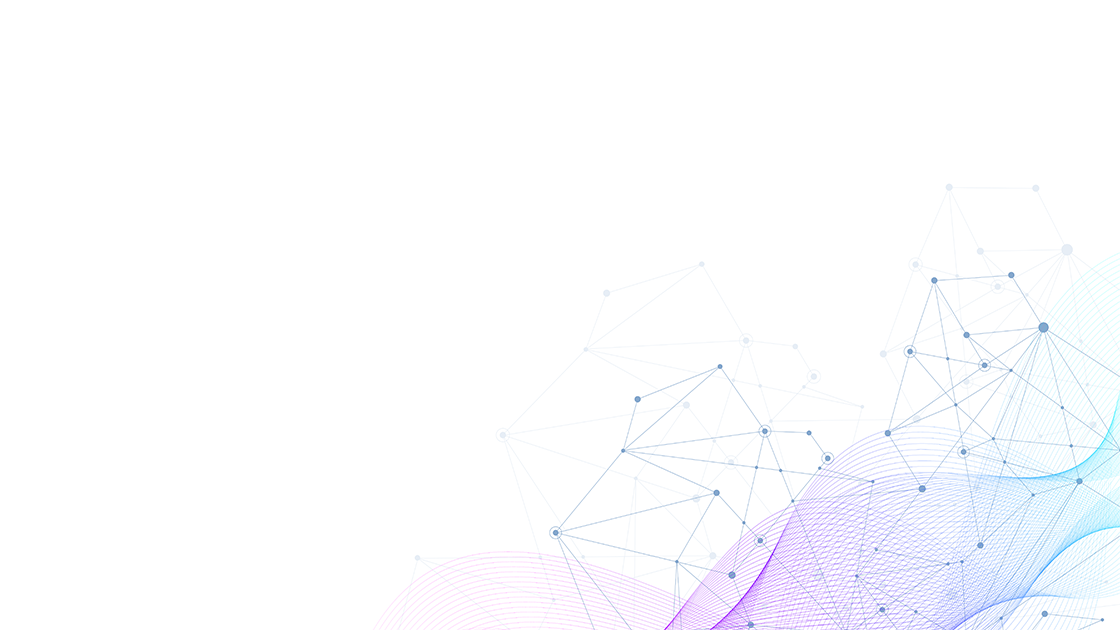IoT for business transforms multiple sectors through real-time data collection, advanced analytics, and automation. IoT also fine-tunes renewable energy sources and in farming, the technology increases agricultural productivity. The future of IoT holds vast potential across various domains by integrating with advanced technologies like AI, 5G, and edge computing. As IoT continues to advance, several startups are leading the way in sustainable innovation. Each utilizes cutting-edge technologies like AI, edge computing, and cloud analytics to drive impactful change.
Why you should read this report?
- Gain in-depth insights into 12 key impacts of IoT on business
- Discover 3 IoT application areas in each trend.
- Learn about 12 innovative startups offering breakthrough solutions.

Key Takeaways
- Tackling Climate Change
- Use Cases:
- Environmental Monitoring
- DER Integration
- Precision Agriculture
- Startup to Watch:
- Use Cases:
- Demographic Shift
- Use Cases:
- Remote Patient Monitoring
- Smart Urban Planning
- Customer Data Acquisition
- Startup to Watch: ONDO Systems
- Use Cases:
- Rapid Urbanization
- Use Cases:
- Traffic Management
- Smart Waste Management
- Building Management Systems
- Startup to Watch: MUSA Green
- Use Cases:
- The Energy Transition
- Use Cases:
- Renewable Energy Management
- Remote Asset Monitoring
- Vehicle to Grid
- Startup to Watch: Greenphard Energy
- Use Cases:
- Future of Mobility
- Use Cases:
- Smart Transportation Systems
- Autonomous Vehicles
- Vehicle-to-Everything (V2X)
- Startup to Watch: GeoSensorX
- Use Cases:
- The Hyper-Connected World
- Use Cases:
- Infrastructure Monitoring
- Smart Waste Management
- Intelligent Traffic Management
- Startup to Watch: Smart City Labs
- Use Cases:
- Rise of technology and industry 5.0
- Use Cases:
- Smart Manufacturing
- Human-Centric Design
- Hyper personalization
- Startup to Watch: Shunya Ekai Technologies
- Use Cases:
- Shifting Economic Trend
- Use Cases:
- Cross-Border Transactions
- Improved Connectivity
- P2P Resource Pooling
- Startup to Watch: Peeriot
- Use Cases:
- Innovating to Zero
- Use Cases:
- Emissions Monitoring
- Process Optimization
- Asset Condition Monitoring
- Startup to Watch: Oyesterable
- Use Cases:
- Health and Wellness Evolution
- Use Cases:
- Wearable Health Devices
- Continuous Health Monitoring
- Personalized Healthcare
- Startup to Watch: Callisia
- Use Cases:
- Uncertain Geopolitical Future
- Use Cases:
- Critical Infrastructure Monitoring
- Real-time Supply Chain Data
- Border Security Monitoring
- Startup to Watch: ID BOTIC
- Use Cases:
- Fracturing World
- Use Cases:
- Cross-Border Data Flow
- Global Connectivity
- Crisis Management
- Use Cases:
- Startup to Watch: Sebelo
What You Need to Know About the Internet of Things
How is IoT being used in business?
IoT in business streamlines operations, improves asset management, and enhances decision-making through real-time data collection. Companies across industries implement IoT devices like sensors and smart meters to monitor equipment performance, track inventory, and optimize supply chain processes.
In manufacturing, IoT enables predictive maintenance by detecting early signs of machine failure, while in retail, it provides insights into consumer behavior and inventory levels, improving stocking strategies. Additionally, IoT supports automation in facilities such as factories and warehouses. Here, the IoT devices control energy use and monitor environmental conditions. Businesses leverage this technology-driven data to gain a competitive edge by enhancing operational efficiency and improving customer experiences.
What are the benefits of IoT for business?
The benefits of IoT for businesses include increased efficiency, cost reduction, and better resource management. IoT devices provide real-time data, allowing businesses to optimize processes, reduce downtime through predictive maintenance, and make data-driven decisions. Automation through IoT lowers operational costs by improving energy efficiency and reducing manual intervention.
Furthermore, IoT improves customer engagement by enabling personalized experiences and services through data insights. In logistics and supply chains, it enhances tracking and transparency, reducing delays and losses. Overall, IoT helps businesses increase their agility, optimize resource utilization, and improve profitability through enhanced visibility and control over operations.
How We Identify Emerging Technologies & Startups
The data in this report originates from StartUs Insights’ Discovery Platform, covering 4.7 million global startups, scaleups, and technology companies, alongside 20,000 emerging technology trends. Our platform makes startup and technology scouting, trend intelligence, and patent searches more efficient by providing deep insights into the technological ecosystem. Utilizing the trend intelligence feature, we analyze industry-specific technologies for this report, detect patterns and trends, and identify use cases along with the startups advancing these areas. Further details and capabilities are accessible via the website.
Top 12 Ways IoT Advances Business [ 2025 & Beyond]
1. Tackling Climate Change
IoT is instrumental in combatting environmental degradation and global warming by providing real-time data. This technology enables real-time data collection, predictive analytics, and automation for effective responses to environmental hazards. IoT empowers energy management, precision agriculture, and urban sustainability by using smart devices and sensors that deliver actionable insights in precision farming. Technologies like smart sensors, edge computing, and cloud analytics enable IoT to conserve resources and tackle climate change.
3 Practical Use Cases of IoT in Tackling Climate Change
- Environmental Monitoring: It includes detecting air quality, water levels, and carbon emissions. The sensor system is enabled by cloud computing and AI models and, therefore, uses real-time data to detect environmental changes and predict analysis.
- DER Integration: IoT sensors monitor energy production and consumption, allowing real-time adjustments to optimize energy distribution. Edge computing and blockchain used with sensors ensure real-time communication between energy assets and utilities.
- Precision Agriculture: Drones along with sensors monitor soil conditions and report water levels to determine adequate watering while reducing their carbon footprint. IoT platforms with AI offer predictive insights to improve yields and resource efficiency.
Startup to look for: 4Climate
4climate develops IoT smart farm automation devices tailored for growers to optimize agricultural efficiency and resource management. Its devices integrate environmental sensors that track key metrics such as air temperature, relative humidity, vapor pressure deficit (VPD), CO2 levels, light intensity (Lux), and photosynthetically active radiation (PAR), providing real-time data to better manage farm environments.
These sensors, designed for various growing media including soil and hydroponics, are available in customizable combinations, helping to reduce costs associated with utilities, nutrients, and labor. By enabling precise monitoring and control of environmental conditions, 4climate’s solutions help prevent crop diseases and improve yield quality, offering growers a streamlined way to enhance productivity and sustainability.
2. Demographic Shift
IoT addresses the evolving needs of global demographic shift by enabling smarter healthcare, adaptive urban infrastructure, and improved resource management. The technology improves elderly care through wearable devices that track patients with chronic diseases.
This system monitors health metrics remotely and makes timely interventions, improving patient outcomes. Additionally, IoT supports workforce safety by monitoring environmental conditions for older workers in real time. As IoT leverages smart sensors, wearables, cloud analytics, and connected infrastructure, it drives personalized and efficient solutions to manage the complexities of demographic change.
3 Practical Use Cases of IoT in Demographic Shift
- Remote Patient Monitoring: IoT-enabled wearable devices and biosensors measure vitals in real-time, with the data being sent to cloud-enabled platforms. These data are collected, stored, and analyzed by healthcare facilities to monitor the status of patients remotely. AI-powered algorithms also ensure timely alerts of any abnormalities being recorded.
- Smart Urban Planning: Sensors used in city infrastructure gather real-time data on traffic flow, energy consumption, and environmental factors to optimize city layouts and resources. This technology relies on big data analytics and machine learning to improve the quality of life for citizens by creating efficient and resilient urban environments.
- Customer Data Acquisition: IoT sensors integrated with AI-driven analytics track customers’ interaction with each product and service. This helps companies to offer personalized experiences. It also predicts trends and suggests marketing strategies for shifting demographics.
Startup to look for: ONDO System
US-based ONDO Systems develops IoT-enabled smart nursing care solutions designed to enhance population management in long-term care for seniors and childcare. The platform integrates with wireless sensors and cloud-based analytics to provide caregivers with continuous insights into patient safety and activity.
ONDO leverages AI-driven alerts to detect critical events, such as falls or changes in vital signs. Also, it tracks environmental data like temperature and air quality to ensure optimal living conditions. ONDO empowers caregivers to provide proactive care, improving overall well-being and operational efficiency in healthcare and childcare environments.
3. Rapid Urbanization
Rapid urbanization and increasing demand for city space give rise to the growing application of IOT. It addresses traffic congestion and waste management through the establishment of smarter cities that allow real-time monitoring and better optimization of available resources. For instance, IoT-powered traffic management systems adjust signal timings based on live data to improve traffic flow and reduce congestion and emissions. This comprehensive urban management relies on a combination of smart sensors, edge computing, cloud analytics, and AI-driven systems that improve mobility and create a livable urban environment.
3 Practical Use Cases of IoT in Rapid Urbanization
- Traffic Management: This technology utilizes sensors, cameras, and vehicle data to monitor traffic patterns and optimize flow. Machine learning algorithms help cities predict and mitigate traffic jams by suggesting alternate routes. This improves overall urban mobility.
- Smart Waste Management: IoT deploys smart bins equipped with sensors that send real-time data to waste collection services, enabling the optimization of collection routes. By using cloud-based analytics and predictive algorithms, waste management teams lower emissions associated with collection processes.
- Building Management Systems: Building management systems use sensors to monitor and control energy usage and lighting in real-time. The HVAC system integrates IoT-connected devices and AI-driven analytics to reduce energy waste and improve sustainability in urban environments.
Startup to look for: MUSA Green
Indonesian startup- MUSA Green integrates IoT monitoring systems into waste management, providing industries with advanced tools to track environmental impacts in real-time. The system connects to a variety of sensors and instruments, automating data collection to optimize processes like emissions control and resource use. MUSA Green’s platform centralizes data management, offering comprehensive analytics for informed decision-making and regulatory compliance. By streamlining operations and reducing waste, the company enables clients to minimize environmental footprints and improve sustainability metrics, ultimately enhancing ESG performance and operational efficiency.
4. The Energy Transition
The IoT in companies enables smart grids to track energy consumption and maintain an optimal balance between supply and demand. A similar approach is used in smart buildings that involve IoT sensors to regulate the work of heating, ventilation, air conditioning, and lighting systems. For instance, sensors installed in a building monitor temperature changes, levels of CO2, and humidity and link them to information based on real-time occupancy and environmental data. Besides, IoT integrates decentralized renewable energy sources like solar and wind into the grid, where excess energy is stored for future peak demand.
3 Practical Use Cases of IoT in the Future of Mobility
- Renewable Energy Management: IoT integrates solar and wind energy with real-time sensors and AI-driven analytics to monitor energy production, predict weather patterns, and balance supply demand. The technology ensures stability and efficiency across the grid.
- Remote Asset Monitoring: IoT predicts faults in high-value assets by leveraging thermal sensors and AI algorithms. The technology integrates with cloud computing scales the operations and ensures 24/7 monitoring capabilities.
- Vehicle-to-Grid (V2G): EVs return unused electricity to the grid during peak demand enabling bidirectional energy flow and also acting as mobile energy storage units. This is made possible by IoT sensors that track battery levels, usage patterns, and charging times, supported by 5G connectivity and AI-driven energy management systems.
Startup to look for: Greenphard Energy
Greenphard Energy develops advanced virtual energy storage technology that transforms power-demanding equipment into virtual batteries, enabling electricity-consuming devices to function as energy resources. By leveraging AI-driven intelligent IoT solutions, the company optimizes power usage through automated control, reducing energy consumption by 10-30% in facilities such as cold storage units, factories, and office buildings.
Greenphard’s platform also integrates demand response (DR) mechanisms, allowing businesses to stabilize power supply and generate additional revenue from electricity markets. With its innovative AI technology and precision IoT control systems, Greenphard Energy offers a sustainable solution that not only cuts costs but also reduces CO2 emissions, supporting businesses in contributing to decarbonization efforts and improving operational efficiency. This dual focus on energy optimization and revenue generation makes Greenphard a key player in addressing global climate challenges through intelligent power management.
5. Future of Mobility
IoT transforms mobility by enabling connected and autonomous vehicles (CAVs) to optimize smart traffic management. It also supports electric vehicle (EV) infrastructure where vehicles can communicate in real-time and improve passenger’s safety. IoT reduces traffic congestion through predictive analytics. Its sensors dynamically manage traffic flow, minimizing delays and emissions. Additionally, IoT supports Mobility as a Service (MaaS), integrating various transport modes into unified digital platforms, promoting seamless travel, and reducing reliance on individual vehicles.
3 Practical Use Cases of IoT in the Future of Mobility
- Smart Transportation Systems: IoT collects traffic data and communicates it to central systems that optimize public transportation. AI algorithms and edge computing is used to dynamically adjust traffic lights and reroute vehicles with real-time updates for the commuters.
- Autonomous cars: Real-time detection of road conditions, barriers, and other cars is facilitated by IoT sensors implanted in vehicles and road infrastructure. 5G networks and artificial intelligence (AI) offer low-latency communication and quick data processing, allowing safe navigation of intricate surroundings.
- Vehicle-to-Everything (V2X): Vehicles interact with road infrastructure (V2I), pedestrians (V2P), and traffic lights (V2X) thanks to the Internet of Things. Vehicles can exchange data quickly thanks to 5G. Cloud computing and IoT sensor integration enable vehicles to make snap decisions.
Startup to look for: GeosensorX
US-based GeoSensorX introduces the DG-800, an IoT data gateway built for enterprise applications, offering secure edge processing for mobile and stationary assets. It supports high-speed LTE Cat4 connectivity, video streaming, Wi-Fi for multiple devices, and Bluetooth sensors. The device features a 72-channel GPS receiver and a 6-axis IMU for precise real-time tracking. With internal flash memory, a backup battery, and plug-and-play installation, the DG-800 ensures reliable performance in any environment. Its value lies in optimizing asset management through seamless connectivity and real-time data monitoring.
6. The Hyper-Connected World
IoT is a central technology in hyperconnectivity to create seamless communication between billions of devices. For instance, in smart cities, IoT integrates with 5G and edge computing for managing urban, and public services, and consumption of energy. It improves urban living environments. IoT is an enabler of experiencing improved urban living through its smart transportation that powers fleet management systems by connecting vehicles to real-time data. The rise of 5G and low-earth orbit satellites will further accelerate hyperconnectivity, driving innovation in autonomous systems and accelerating real-time data processing on a global scale.
3 Practical Use Cases of IoT in The Hyper-Connected World
- Infrastructure Monitoring: IoT sensors collect real-time data on structural health, and identify potential issues like cracks or wear in public infrastructure. It uses edge computing and AI to analyze this data and provide predictive maintenance insights.
- Smart Waste Management: IoT deploys smart bins equipped with sensors to monitor waste levels in real time. This data used cloud computing to aggregate and analyze this data to provide actionable insights and optimize waste collection routes.
- Intelligent Traffic Management: It uses connected sensors and cameras to analyze traffic patterns and monitor its flow and congestion in real time. Technologies such as machine learning and 5G connectivity enhance these systems by enabling faster data processing thus reducing congestion and improving urban mobility.
Startup to look for: Smart City Labs
US-based startup Smart City Labs enhances urban environments through IoT technology integration. It connects the public and private sectors by building smart infrastructure and incorporating IoT sensors, fiber optics, and wireless networks. The platform optimizes resource management and improves connectivity in cities and campuses. Smart City Labs leverages real-time data analytics with smart building applications for immersive media experiences through augmented and virtual reality. The company enhances public services and community engagement making cities safer, more connected, and more sustainable.
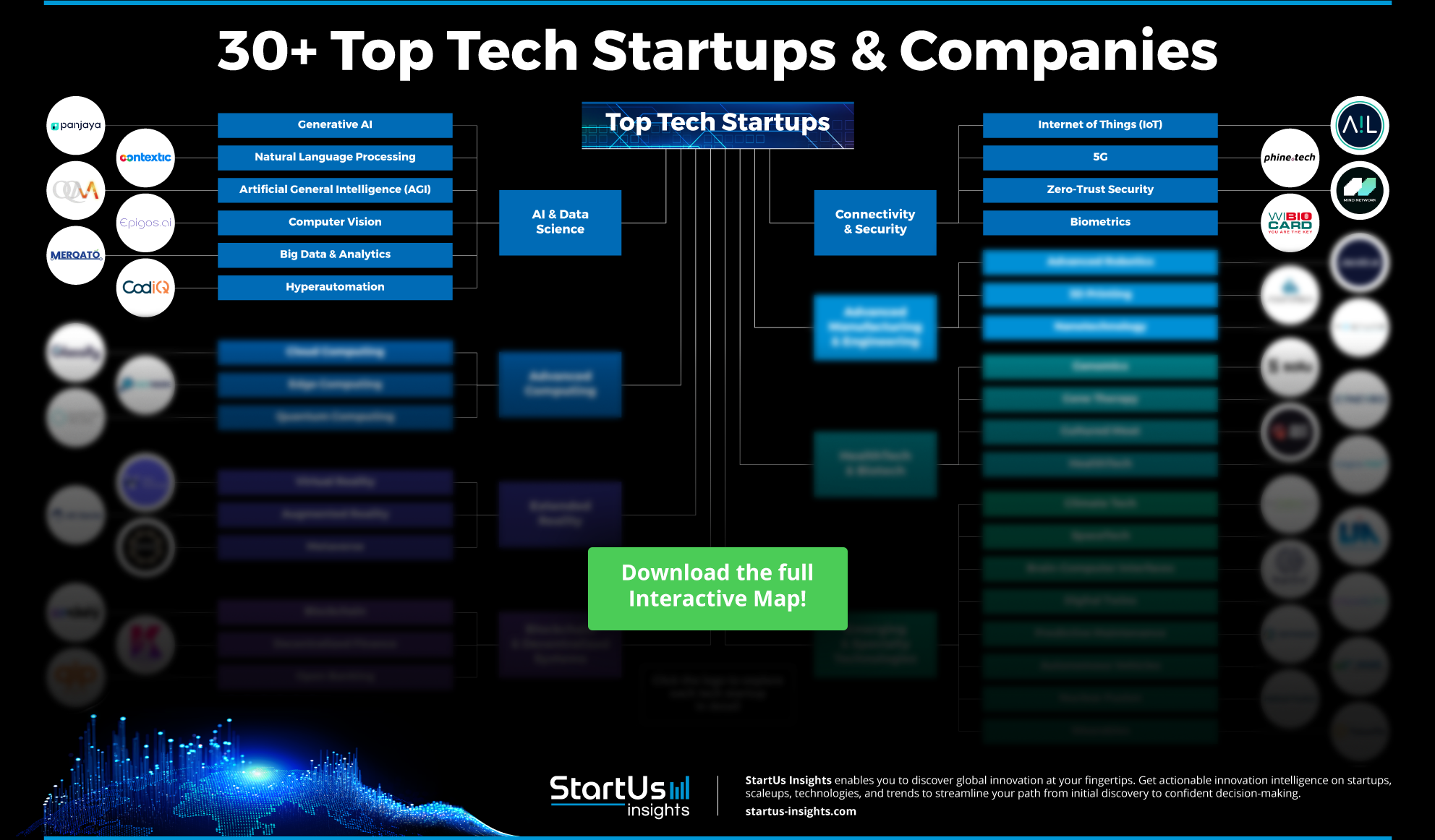
7. Rise of technology and industry 5.0
Industry 5.0 emphasizes human-centric design that supports sustainability and encourages collaboration between humans and machines. IoT driving this shift by enabling enhanced connectivity between devices and real-time data analytics. For instance, cobots where human workers and machines collaborate to improve precision and reduce errors. Further, IoT sensors in smart factories continuously monitor equipment for predictive maintenance.
Additionally, this technology also allows production lines to adapt mass customization, catering to the growing demand for personalized products. By integrating IoT-connected machinery, AI algorithms, and cloud-based control systems, Industry 5.0 innovations support sustainable goals.
3 Practical Use Cases of IoT in Rise of Technology and Industry 5.0
- Smart Manufacturing: IoT connects machines, sensors, and systems on the factory floor for real-time data collection and advanced analytics. It monitors equipment performance and optimizes production processes by leveraging cloud computing and AI-driven analytics.
- Human-Centric Design: IoT integrates with human-machine interfaces (HMIs), such as augmented reality (AR) and wearable devices, to enhance worker interaction with machines. This integration improves worker safety and enables seamless collaboration between humans and robots.
- Hyper personalization: In industries like consumer electronics and automotive, IoT enables manufacturers to customize products based on real-time customer preferences. IoT devices gather data about customer needs and feed it into production systems, where AI algorithms and digital twins can adjust processes to create personalized products.
Startup to look for: Shunya Ekai Technologies
Indian startup- Shunya Ekai Technologies develops IoT devices and autonomous mobility bots to automate operations and enhance efficiency across industries. Its technology integrates artificial intelligence, machine learning, and 3D printing, enabling smart devices to perform complex tasks autonomously. The IoT devices gather real-time data from sensors and systems, providing valuable insights for process optimization. Additionally, their robots and devices feature AI for computer vision, allowing them to analyze and respond to environmental stimuli. The company’s solutions drive automation, streamline tasks and improve operational efficiency for businesses across multiple sectors.
8. Shifting Economic Trend
The shift in economic trends reflects major challenges like supply chain disruptions and sustainability concerns. IoT supports this shift by enabling smart decision-making and automation through real-time data sharing and resource optimization. For instance, real-time tracking of goods streamlines logistics and reduces bottlenecks in supply chains. Similarly, in retail, IoT systems track inventory in real time, improving demand forecasting and maintaining optimal stock levels. These systems rely on sensors, cloud connectivity, AI, and edge computing to support industries in adapting to economic transformations effectively.
3 Practical Use Cases of IoT in Shifting Economic Trends
- Cross-Border Transactions: IoT integrates with blockchain and AI-powered automation for real-time processing of transactions and improving security. It optimizes foreign exchange (FX) rates in real time. APIs integrate these payments directly into existing business infrastructure to enhance transparency across borders.
- Improved Connectivity: LPWA (Low Power Wide Area) networks allow IoT devices to operate with low energy consumption and longer range, ensuring seamless connectivity across borders, even in remote areas. This enables industries to monitor operations across international sites in real time and ensure faster responses to changes.
- P2P Resource Pooling: IoT facilitates peer-to-peer (P2P) resource pooling to share resources efficiently. IoT sensors and blockchain technology work together to track and monitor shared resources, such as vehicles or warehouse space, allowing participants to share excess capacity.
Startup to look for: Peeriot
German startup, Peeriot builds decentralized IoT networks through peer-to-peer (P2P) connectivity, using its low-code software suite to enable secure, self-organized data exchange. Its core product, Peeriot.Swarm automates the setup, operation, and management of IoT systems by connecting autonomous devices that exchange real-time data. The system’s key benefits include simplifying IoT data handling, enhancing interoperability through technology-agnostic design, and enabling seamless device collaboration. Peeriot empowers enterprises to efficiently manage IoT ecosystems while ensuring data security and privacy.
9. Innovating to zero
IoT is shifting focus to reducing emissions by process optimization tools and advanced monitoring. IoT technologies such as smart grids improve energy efficiency by monitoring and balancing supply and demand in real time. This reduces energy wastage and emissions from traditional power sources. In smart transportation, IoT optimizes traffic flow and supports electric vehicle charging networks, reducing congestion and emissions. This technology enhances precision farming by optimizing water and fertilizer use, therefore minimizing environmental degradation. IoT is essential for reducing industrial impact and enhancing environmental responsibility.
3 Practical Use Cases of IoT in Innovating to Zero
- Emissions Monitoring: IoT enables real-time tracking of pollutants like methane and carbon dioxide by leveraging IoT sensors, cloud computing, and AI. It detects leaks, quantifies emissions, and provides insights for remediation.
- Process Optimization in Manufacturing: IoT sensors embedded in manufacturing processes optimize production lines and reduce energy consumption. It leverages edge computing and AI-driven analytics to monitor equipment performance in real-time.
- Asset Condition Monitoring: IoT enables continuous asset monitoring with smart sensors and predictive analytics. It monitors critical parameters like vibration, temperature, and pressure to detect early signs of wear and tear extending the lifespan of assets.
Startup to look for: Oyesterable
South Korean startup Oyesterable provides an AIoT circular economy solution focused on sustainable packaging and waste management through its Lalaloop platform. It automates the collection of reusables and recyclables via Reverse Vending Machines and offers real-time reward tracking through its digital passport system for product packaging. The platform integrates various data technologies like RFID and QR codes to manage carbon credits for individuals and corporations, creating a closed-loop system that enhances sustainability efforts. Oyesterable enables businesses and governments to promote environmental responsibility while boosting consumer engagement through incentives.
10. Health and Wellness Evolution
The growing demand for proactive health management solutions drives IoT to enable real-time monitoring, personalized care, and remote healthcare access. Remote patient monitoring uses IoT sensors to track vital signs and improve chronic disease management. Moreover, wearable health devices, where patient gains personalized wellness insights by monitoring activity and sleep patterns leads to healthier lifestyles. Smart medication management systems also uses IoT-enabled pillboxes to ensure adherence to medication schedules. These technologies streamline healthcare delivery, reduce costs, and enhance patient outcomes.
3 Practical Use Cases of IoT in Health and Wellness Evolution
- Wearable Health Devices: Smartwatches and medical-grade sensors continuously monitor chronic conditions through real-time data on critical health metrics. This integration of AI and biometric sensors improves early diagnosis and treatment
- Continuous Health Monitoring: IoT sensors detect anomalies in daily activities of elderly and alert caregivers about potential health issues, promoting independence and preventing emergencies. This AI-driven analytics ensures timely interventions and enhances the quality of life for aging populations
- Personalized Healthcare: Glucose monitors and blood pressure sensors leverages cloud computing and machine learning algorithms to send real-time data to healthcare providers, enabling adjustments in treatment plans without the need for frequent hospital visits.
Startup to look for: Callisia
Italy-based Callisia develops IoT wearable devices that anticipate clinical risks by monitoring patient health data in real time through interchangeable biosensors. Its open hardware platform connects to a secure data processing system, driven by AI models to analyze multiple pathologies. The device is non-invasive, privacy-oriented, and customizable to fit specific healthcare needs. Key features include continuous monitoring, fast data analysis, and mobile app integration. Callisia aims to enhance patient care by providing actionable insights to healthcare providers, improving outcomes, and supporting proactive medical intervention
11. Uncertain Geopolitical Future
The uncertain geopolitical future necessitates IoT to improve military and defense systems while also transforming critical infrastructure. First, IoT combined with blockchain secures data exchange and privacy to protect sensitive geopolitical data across borders. In defense, IoT improves surveillance and threat detection by integrating AI to process real-time data, strengthening defense capabilities. Moreover, IoT in smart supply chains helps track goods globally increasing transparency and reducing risks related to geopolitical tensions. IoT integrates with 5G, AI, and edge computing to bring more resilience in geopolitical systems.
3 Practical Use Cases of IoT in Uncertain Geopolitical Future
- Critical Infrastructure Monitoring: IoT sensors in energy grids, water systems, and transportation networks provide real-time updates on the status of essential services, allowing governments to detect faults and threats early. IoT uses edge computing and cloud-based analytics to process large volumes of sensor data instantly.
- Real-Time Supply Chain Data: IoT-enabled devices, in combination with blockchain for transparency and security track goods, monitor storage conditions, and ensure regulatory compliance to prevent disruptions in the flow of essential commodities. This is particularly crucial during geopolitical tension or sanctions, where supply chains might be threatened.
- Border Security Monitoring: In regions with high geopolitical instability, border security leverages sensor networks and drones to monitor vast border areas, providing real-time surveillance and data analytics to track unauthorized crossings or breaches.
Startup to look for: ID BOTIC
Spanish startup ID BOTIC develops hardware encryption and authentication solutions for IoT communications in defense, industry, and telecommunications sectors. Its technology secures machine-to-machine communications through real-time key exchange, offering multi-level encrypted communication and network authentication for Ethernet, fiber optics, and industrial buses. ID BOTIC’s devices support cybersecurity for next-generation public and private networks, including 4G, 5G, and beyond, ensuring secure and reliable data transfer. The company aims to safeguard critical infrastructure by delivering cutting-edge encryption technology that enhances the security and integrity of connected systems.
12. Fracturing world
The Internet of Things bridges gaps caused by fragmentation therefore supporting resilience and corporations in critical areas. For instance, bringing connectivity to underserved communities where IoT leverages wireless technology in politically or economically fragmented regions. Another key application is IoT-enabled environmental monitoring. This involves using IoT sensors to track and manage air quality, water levels, and pollution in real-time across borders. The technology also monitors cross-border ecosystems for better management and conservation efforts.
3 Practical Use Cases of IoT in Fracturing World
- Cross-Border Data Flow: IoT-enabled platforms coupled with cloud platforms, edge computing, and blockchain ensure seamless data exchange across borders by managing data localization challenges. It securely transfers data while meeting diverse regulatory requirements. Therefore, facilitating the flow of essential information between countries, and helping nations navigate geopolitical restrictions on data exchange.
- Global Connectivity with IoT in Smart Cities: Smart city infrastructure integrates IoT devices with low-latency communication networks to ensure efficient management of urban services such as transportation, energy, and waste management. For instance, the G20 Smart Cities Alliance promotes collaboration between cities globally by enabling IoT to improve citizen services and accelerate digital transformation, even in regions affected by political or economic fragmentation
- Crisis Management in Disaster-Prone Areas: In the wake of natural disasters or pandemics, IoT sensors leverage satellites and big data analytics to monitor environmental conditions, track supply chains, and optimize the distribution of aid.
Startup to look for: Sebelo
Latvian startup, Sebelo develops LoRaWAN-based forest fire detection sensors, offering real-time fire monitoring across forests using AI-driven technology. Its smokeSense sensors detect fires in minutes by continuously measuring environmental parameters like humidity, temperature, and air quality. The sensors communicate through the LoRaWAN network, supported by smokeRepeater signal extenders for data transmission even in remote areas. The system integrates with existing platforms via an open API. Sebelo’s solution mitigates forest fire damage, contributing to environmental protection and reducing carbon emissions while maintaining long-term operational efficiency.
Don’t Miss Out on the Latest IoT Innovations
Ready to leverage the latest IoT innovations shaping the future? With StartUs Insights, you gain quick and easy access to over 4.7 million startups, scaleups, and tech companies, along with 20,000 emerging technologies and trends. Our AI-powered search and real-time database provide exclusive solutions that set you apart from the competition.
Industry giants like Samsung, Nestlé, and Magna trust our innovation intelligence tools to lead trends, optimize operations, and uncover new market opportunities. Benefit from our unmatched data, comprehensive industry views, and reliable insights to drive strategic decision-making. Get in touch to learn how our tailored discovery options can accelerate your innovation journey.
Discover All IoT Innovations & Startups!

